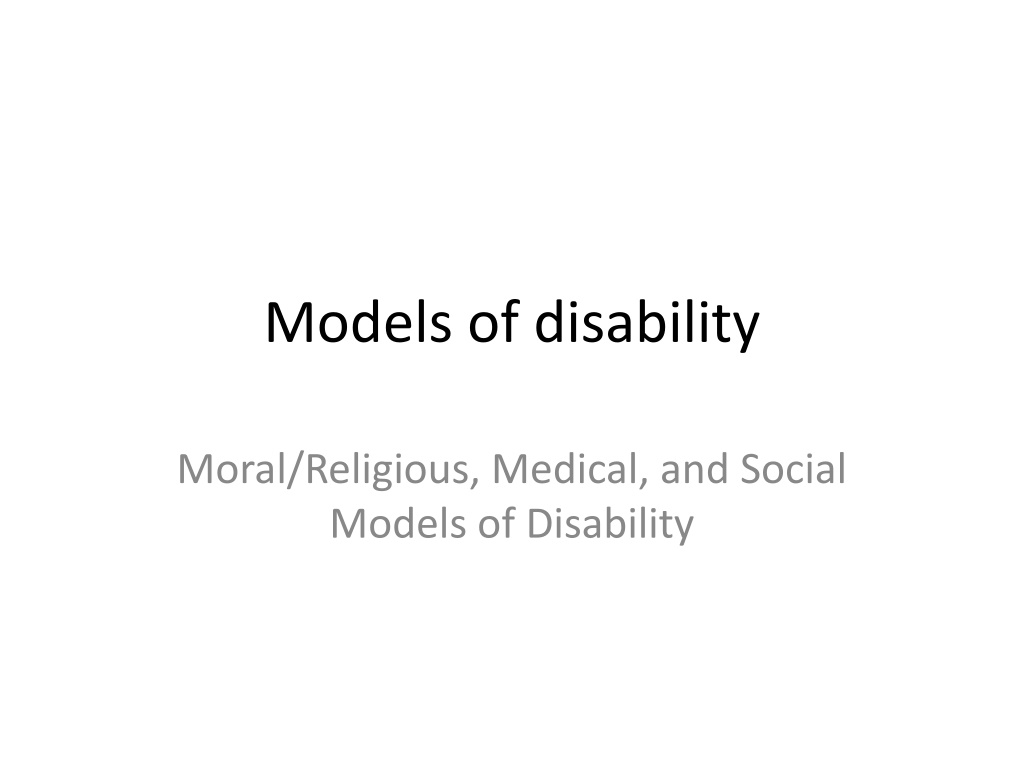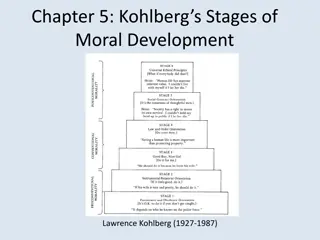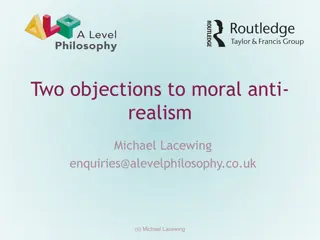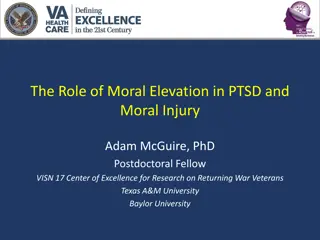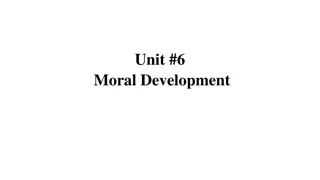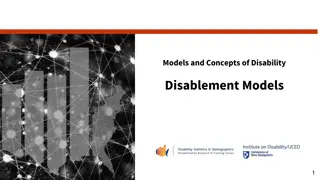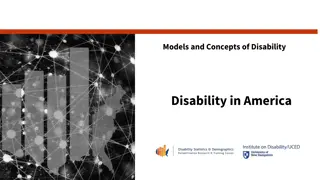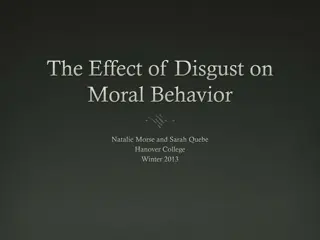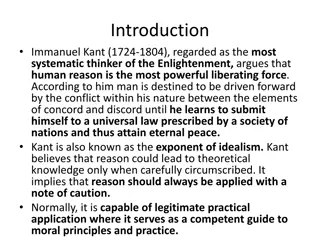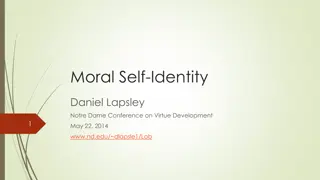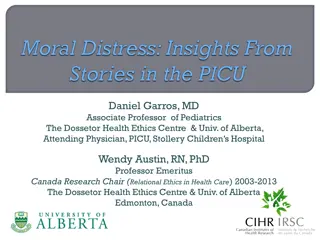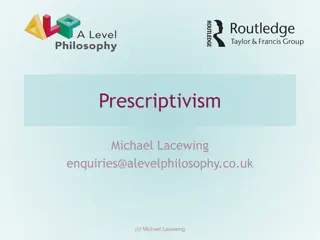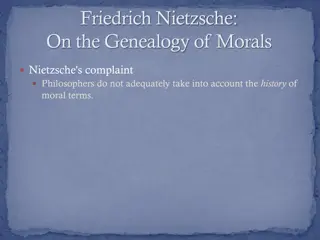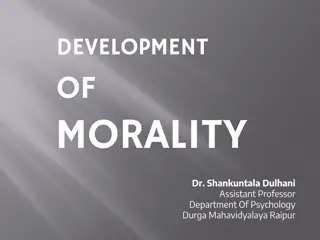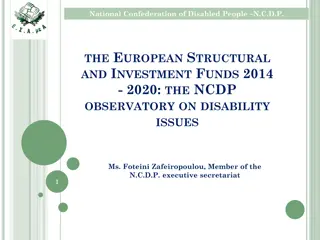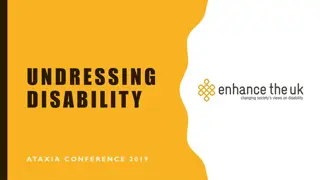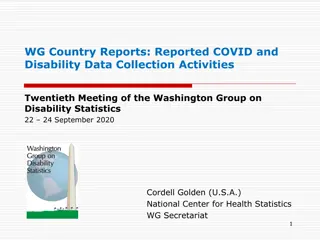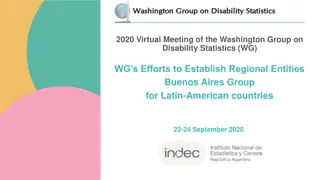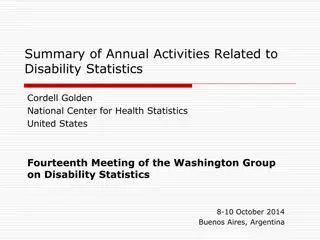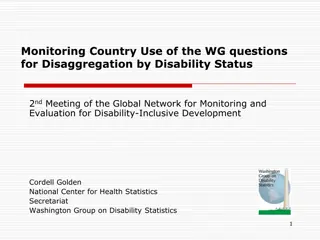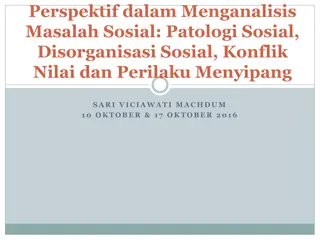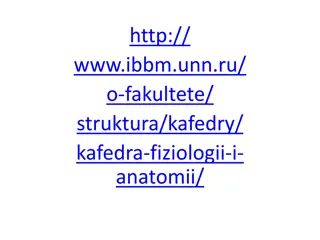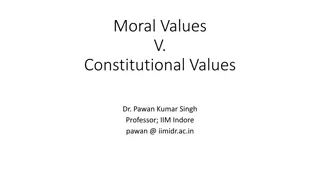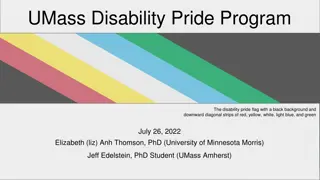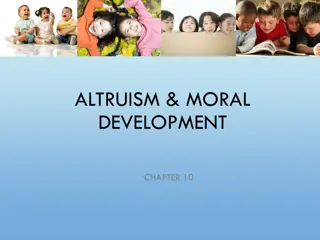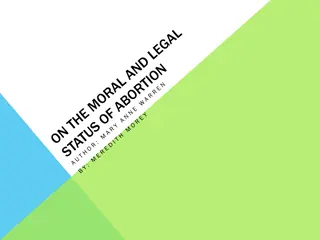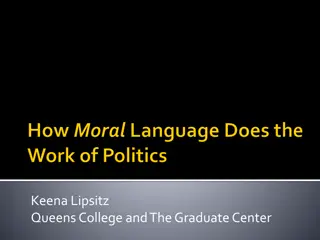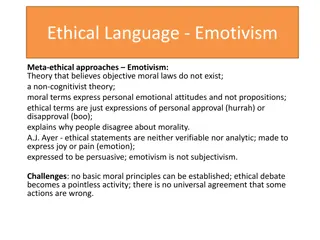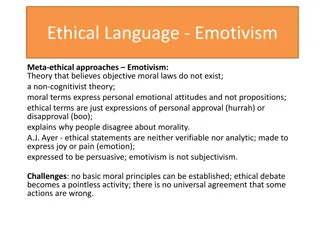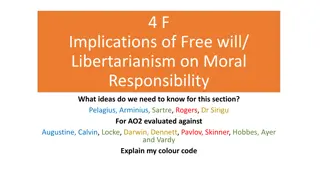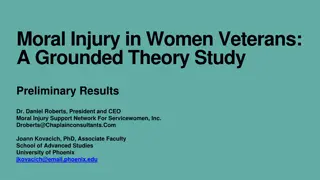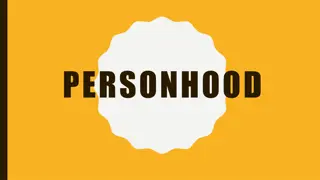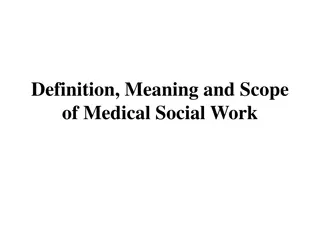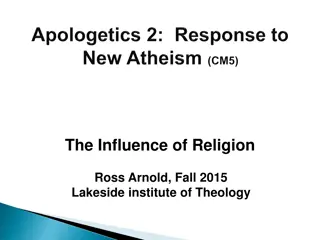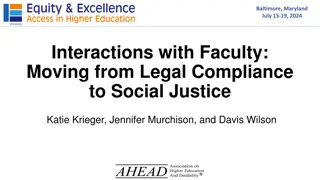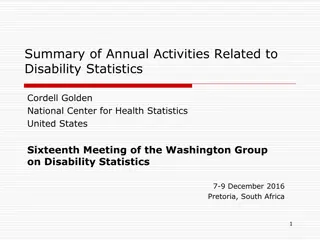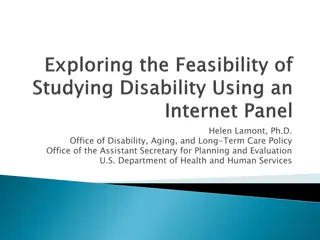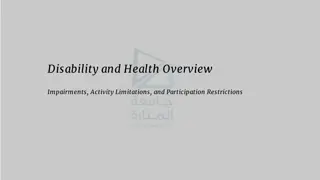Understanding Models of Disability: Moral, Medical, and Social Perspectives
The concept of disability is explored through moral/religious, medical, and social models. Impairment refers to a loss or abnormality in structure or function, while disability is a restriction in performing activities. The discussion also delves into the significance of person-first language and the moral/religious model attributing disabilities to sin or supernatural causes.
Download Presentation

Please find below an Image/Link to download the presentation.
The content on the website is provided AS IS for your information and personal use only. It may not be sold, licensed, or shared on other websites without obtaining consent from the author. Download presentation by click this link. If you encounter any issues during the download, it is possible that the publisher has removed the file from their server.
E N D
Presentation Transcript
Models of disability Moral/Religious, Medical, and Social Models of Disability
Impairment Impairment is lacking all or part of a limb, or having a defective limb, organ or mechanism of the body (UPIAS, 1976). refers to "any loss or abnormality of psychological, physiological or anatomical structure or function" (WHO, 1980).
Disability Disability is any restriction or lack (resulting from an impairment) of ability to perform an activity in the manner or within the range considered normal for a human being (WHO, 1980) Disability is the disadvantage or restriction of activity caused by a contemporary social organization which takes no or little account of people who have physical impairments and thus excludes them from participation in the mainstream of social activities (UPIAS, 1976).
Labelling Those who are in favor of the principle of people/person-first language (those who support the phrase persons with disabilities ) argue that it is essential to recognize that individuals are people first, and that disability may be just one of a person s characteristics, not the overriding characteristic of the individuals.
Labelling (cont) However, many scholars in disability studies in the UK assert that person-first language implies that disability is located within individuals rather than a societal construction. Such scholars contend that disabled people are not people with disabilities, rather, they are people who are disabled (disadvantaged) by society s response to their differences . Thus, they use disabled persons in referring to these group of people.
Moral/Religious Model The moral/religious model represents the oldest and also the most pervasive framework for understanding disability. By promulgating the belief that impairments are the result of sin, witchcraft, the evil eye, the wrath and judgment of God/gods or an ancestor s anger, religions have sought to regulate and control the behavior of their adherents through fear and the threat of supernatural punishment.
Moral/Religious Model (cont) Shared by most cultures throughout the world, this model is evident in all the major religions. In the Old Testament, disabled people were regarded as unclean . Characteristics that would keep a priest from the temple included being blind, being lame, having a malformed foot or a misshaped hand, being a dwarf, or having a broken bone.
Disability in Hinduism and Buddhism Hindu mythology portrays impairments in extremely negative terms: as flaws or deficiencies that must be endured to repay past sin; associating impairment with deceit, mischief and evil. Buddhism teaches that impairments constitute a form of educational rebirth for wrong conduct in previous incarnations.
Positive Implications Judeo-Christian religious tradition offers many lessons on the dignity and worth of persons with disabilities. Moses had a significant speech impairment. God implied, in choosing Moses as a leader, that some people with disabilities are worthy and capable of leadership. When Moses remained unconvinced, God provided what we might today term "reasonable accommodation" in Aaron to help Moses speak to his people.
Medical/Individual Model Commonly referred to as either the medical model or the individual model of disability, this model is the most well-known understanding of disability both by the general public and professionals throughout the modern history of societies This model is rooted in the scientific method of medical science with a belief that science could solve any problem.
Basic Characteristics of the Medical Model The focus of the problem of disability exclusively centers on the individual with the disability; not on the environment Biological impairment is the fundamental starting point and disability is interpreted according to an epidemiological standpoint Profound reliance on the knowledge and skills of professionals for solutions and intervention to problems
Basic Characteristics of the Medical Model (cont) Making its focus on functional limitations and their effects on daily living activities, the medical model seeks preventing, curing, perfecting, eradicating the physical or mental dysfunction, normalizing the abnormal through treatment, or when these goals fail to achieve, caring for disabled people.
Basic Characteristics of the Medical Model (cont) In sum, the medical model regards disability as a problem of the person, directly caused by disease, illness, injury, or other forms of health issues, which require interventions/treatments provided by medical and other professionals with the aim of curing, or bringing about behavior change or one s adjustment to the environment.
Criticisms For their individualization , medicalization , professionalization , and objectification of disability, the individual perspectives are severely critiqued by scholars and activists in the field of disability.
Consequences of the Moral/Religious and Medical Models Manifestations of the disadvantages of the moral/religious and medical models Containment limiting the choices, exposure, and life experiences of disabled persons, as well as the opportunities for disabled persons to fully participate in society, and may be geographical, psychological, or social; Expendability the feeling that the lives of people with disabilities are expendable (they are better of dead);
Consequences (cont) Compartmentalization (the stereotyping of PWDs, or placing them in predetermined categories); Blaming the victim (believing lives of PWDs are limited because of their disabilities or lack of pluck); and Denial of disability (either PWDs pretend as they were not disabled or redefined obvious disabled attributes in a nondisabled fashion).
Social Model of Disability The root of the social model of disability is traced in the political action of disability rights movements in the UK in the 1960s through the 1990s and civil rights movements in the US in the 1960s and 1970s. However, this model is often referred to as the minority group model in the US and caused the independent living and civil rights movements of PWDs there.
UPIAS In 1976, the British Union of the Physically Impaired against Segregation (UPIAS) published its manifesto under a title Fundamental Principles of Disability from which the social model of disability had originated. In 1983, Mike Oliver introduced the term social model and added a research perspective on what UPIAS proposed.
The Social Model Interprets disability is all the things that impose restrictions on disabled people (through individual prejudice, institutional discrimination, inaccessible public buildings, unusable transport systems, segregated education, and excluding work arrangements) therefore, claims that disability is a particular form of social oppression that takes place in a disabling society, and the disabled constitute amongst the group of oppressed population
The Social Model (cont) hence, take disability not to be something wrong with an individual, rather, disability is something wrong with society consequently, call for social reform or change in the hostile socio-political environment which is disabling people with impairments.
Impairment and Disability in the Social Model An inability to walk is an impairment, whereas an inability to enter a building because the entrance is up a flight of steps is a disability. An inability to speak is an impairment but an inability to communicate because appropriate technical aids are not made available is a disability. An inability to move one s body is an impairment but an inability to get out of bed because appropriate physical help is not available is a disability (Morris, 1993, as cited in Barnes, 2003, p.17).
Impacts of the Social Model Adoption of various international declarations and conventions which are concerned with the issues of the disabled The global expansion of community-based rehabilitation programs The introduction of a number of anti- discrimination laws at national levels throughout many countries in the world The worldwide push for inclusive education
Critiques of the Social Model Focusing too much on persons with physical disabilities Neglecting of impairment as an important aspect of many disabled people's lives and underemphasizing problems related to medical or clinical conditions The analogy of disability with gender and racial oppressions The social model is an urban model of disability The concept of the barrier-free utopia
ICF On their own, neither the medical/individual model nor social model is adequate. Both are partially valid and hence, we cannot wholly reject either kind of intervention. ICF thus is a bio psychosocial model-an integration of medical and social models. Disability is a complex phenomena that is both a problem at the level of a person's body, and a complex and primarily social phenomena.
Functioning and Disability In ICF, disability and functioning are viewed as outcomes of interactions between health conditions (diseases, disorders and injuries) and contextual factors. Disability is always an interaction between features of the person (the person with a certain health condition) and features of the overall context in which the person lives.
Functioning and Disability (cont) Functioning is an umbrella term for body functions, body structures, activities and participation. It denotes the positive aspects of the interaction between an individual (with a health condition) and that individual's contextual factors (environmental and personal factors). Disability is an umbrella term for impairments, activity limitations and participation restrictions. It denotes the negative aspects of the interaction between an individual and his/her contextual factors
Body Function, Body Structure, Impairment Body functions are the physiological functions of body systems, including psychological functions. Body refers to the human organism as a whole, and thus includes the brain. Body structures are the structural or anatomical parts of the body such as organs, limbs and their components classified according to body systems. Impairment is a loss or abnormality in body structure or physiological function (including mental functions).
Activity and Activity Limitation Activity is the execution of a task or action by an individual. Activity limitations are difficulties an individual may have in executing activities. An activity limitation may range from a slight to a severe deviation.
Participation and Participation Restriction Participation is a person's involvement in a life situation. It represents the societal perspective of functioning. Participation restrictions are problems an individual may experience in involvement in life situations.
Contextual Factors Contextual factors (personal and environmental factors) are the factors that together constitute the complete context of an individual s life. Environmental factors constitute a component of ICF, and refer to all aspects of the external or extrinsic world that form the context of an individual s life and, as such, have an impact on that person's functioning. Personal factors are contextual factors that relate to the individual such as age, gender, social status, life experiences and so on.
Aims of ICF to provide a scientific basis for understanding and studying health and health-related states, outcomes and determinants; to establish a common language for describing health and health-related states in order to improve communication between different users, such as health care workers, researchers, policy- makers and the public, including people with disabilities; to permit comparison of data across countries, health care disciplines, services and time
Strengths and Limitations of ICF Strength: Non-reductive in theorizing disability Universality-ICF is about all of humanity; it is not a classification for or about a particular group of people Limitations: Lack of specificity and clarity to what activity and participation constitute. Offers no account of how or why disability comes about
Social Constructionist Version of Disability There is no inherent meaning of disability other than ones assigned by a community. Thus, disability only emerges once it has been interpreted. even the most observable disorders such as visual impairment, are no more than cultural and linguistic expressions which do not have existence by their own and independent of culture and society.
Social Constructionist Version (cont) Disability is an elastic social category which is formed and reformed by public policy and professional practice, and underlying them, by societal arrangements and cultural values. Consequently, the attributes of disability varies across cultures ranging from negative discrimination, acceptance, and to positive attribution of supernatural powers and hence, disability is hardly a unitary concept.
Critiques Critiques argue that social constructionist version of disability is by far divorced from reality because of which has brought no meaningful effect in the lives of PWDs. Moreover, as critiques argue, it is not at all useful for advocacy strategy as well as service provisions for PWDs facing barriers and discrimination and who are in need of our intervention
